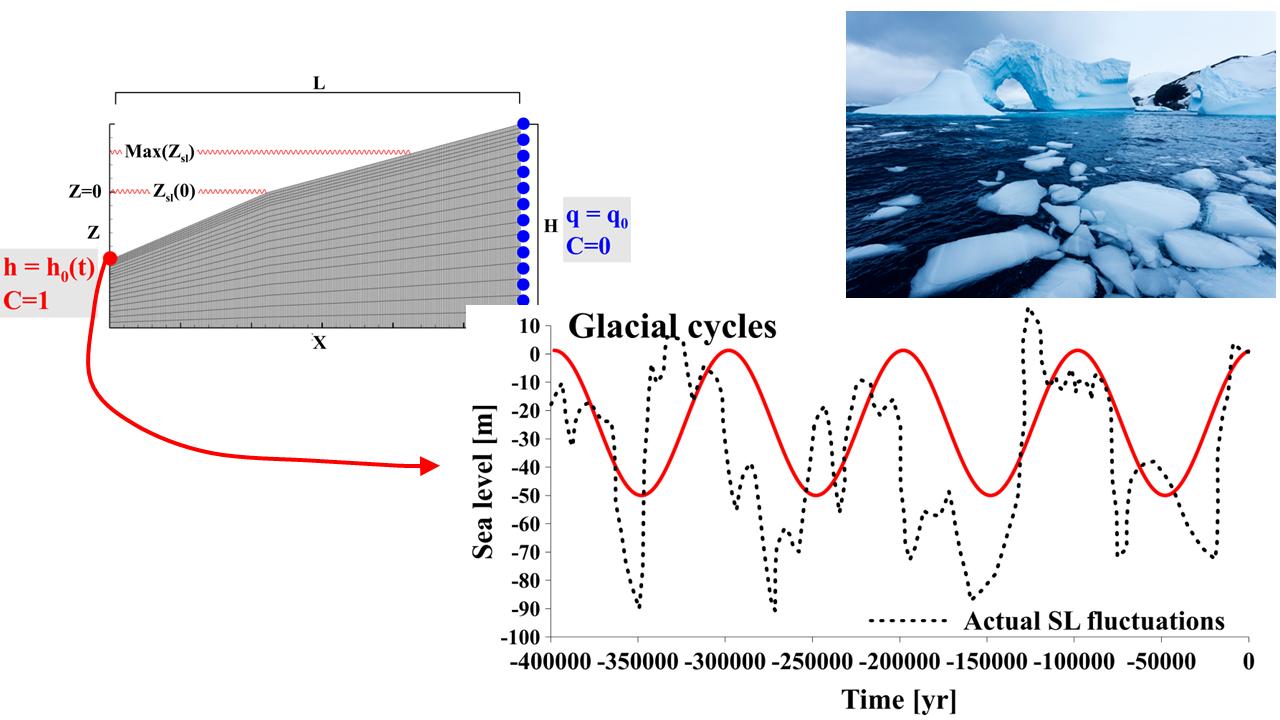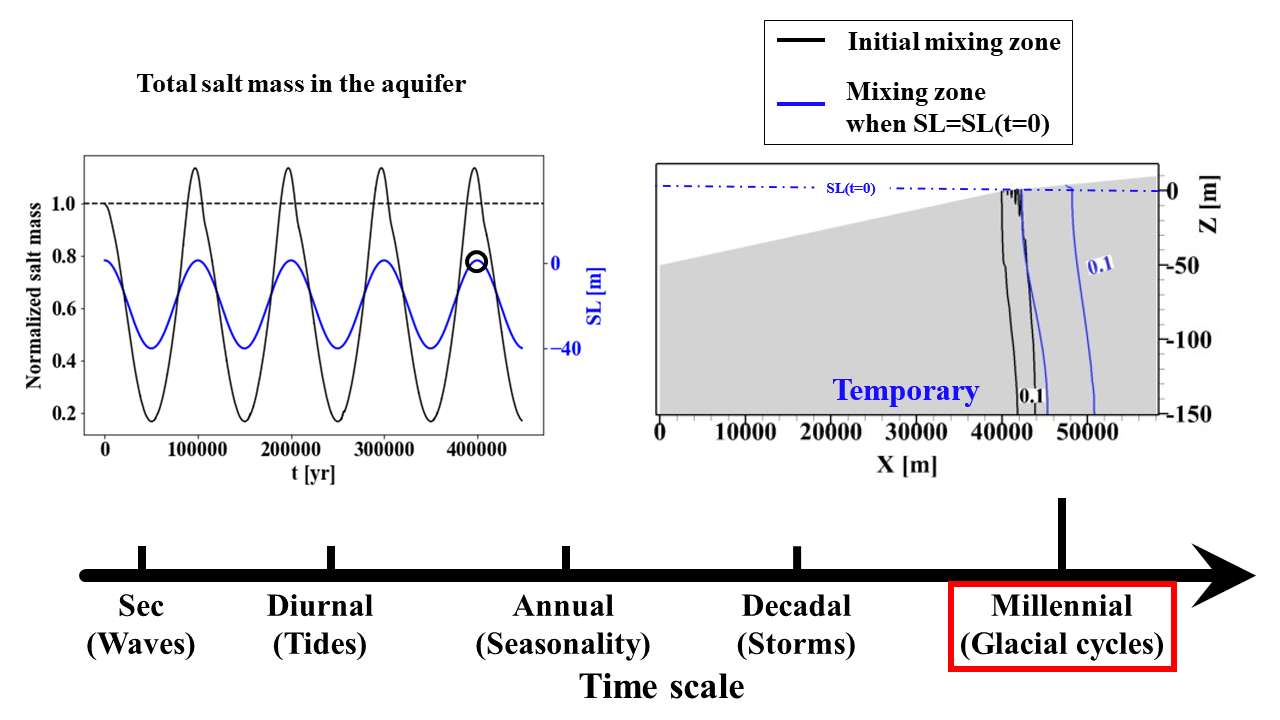HGS RESEARCH HIGHLIGHT – Dynamic Steady State in Coastal Aquifers Is Driven by Multi‐Scale Cyclical Processes, Controlled by Aquifer Storativity.
Paldor, A., Frederiks, R. S., & Michael, H. A. (2022). Dynamic Steady State in Coastal Aquifers Is Driven by Multi‐Scale Cyclical Processes, Controlled by Aquifer Storativity. In Geophysical Research Letters (Vol. 49, Issue 11). American Geophysical Union (AGU). https://doi.org/10.1029/2022gl098599
CLICK HERE TO READ THE ARTICLE.
A new paper by our friends at the University of Delaware explores the effects that periodic/cyclical processes over different time scales exert on salinity distribution throughout coastal aquifers. In other words, how is aquifer salinity impacted by sea-level changes caused by tidal effects (sub-daily), storm-surges (decadal) and glaciation (millennial scale).
Glacial-scale changes in sea level as simulated (red curve) and the reconstructed paleo sea levels in black dashed line (Person et al., 2003). Red/blue points in the upper-left panel are the model nodes where sea level and recharge boundary conditions were applied, respectively.
One key finding from this research is that high-frequency changes in sea level (i.e. the tides, and repeated storm-surges) can result in a long-term increase in the average salinity of coastal aquifers, while low-frequency processes seem to exert no long-term impacts on average aquifer salinity. However, these low-frequency changes in sea level point to inconsistencies between the present day salinity distribution and those produced under dynamic steady-state conditions, since these systems are still actively responding to these long-term cycles!
These findings are very significant for anyone performing hydrologic, density-dependent flow modeling in coastal aquifers. To quote the authors directly:
”In many hydrogeologic studies of coastal systems, the aim is to calibrate a groundwater flow and salt transport model based on field observations. The most common practice in such studies is to run a steady-state simulation of the studied area, with the model parameters adapted to match the modeled steady state to the observed average state of the aquifer. […] This approach assumes that the steady state of the aquifer is reflected in the calibration targets, which are commonly the observed long-term averaged heads and salinities. Such an assumption can lead to erroneous initial conditions and calibrated parameter values which could potentially invalidate transient simulations and long-term predictions based on them. One aquifer parameter that is commonly ignored in the calibration of numerical models is the storativity which measures an aquifer's response to changes in the hydraulic regime, and therefore drops out of the steady-state groundwater flow equation. This is a common approach in hydrogeologic modeling, and our findings suggest that a paradigm shift may be needed, as storativity likely plays an important role in dictating the average salinities when considering relatively high-frequency […] cyclical forcings. This suggested paradigm shift raises an important question regarding the spin-up time required in hydrogeologic modeling.”
Normalized salt mass and the applied BC (blue curve) for the glacial-scale fluctuations in sea level (left) and the distribution of the mixing zone in steady-state conditions (black) and for transient conditions (blue) delineated by the C = 0.1 (labeled) and the C = 0.9 contours based on glacial fluctuations in sea level (right).
CLICK HERE TO READ THE ARTICLE.
Abstract:
Coastal aquifers supply freshwater to nearly half the global population, yet they are threatened by salinization. Salinities are typically estimated assuming steady-state, neglecting the effect of cyclical forcings on average salinity distributions. Here, numerical modeling is used to test this assumption. Multi-scale fluctuations in sea level (SL) are simulated, from tides to glacial cycles. Results show that high-frequency fluctuations alter average salinities compared with the steady-state distribution produced by average SL. Low-frequency forcing generates discrepancies between present-day salinities estimated with and without considering the cyclical forcing due to overshoot effects. This implies that salinities in coastal aquifers may be erroneously estimated when assuming steady-state conditions, since present distributions are likely part of a dynamic steady state that includes forcing on multiple timescales. Further, typically neglected aquifer storage characteristics can strongly control average salinity distributions. This has important implications for managing vulnerable coastal groundwater resources and for calibration of hydrogeological models.
Plain Language Summary:
Coastal communities rely heavily on groundwater for freshwater supply, and the primary risk for this vital resource is salinization. Multiple processes in the ocean-land interface control the salinity of coastal aquifers, and assessments of salinities typically neglect some of these processes. In this work, we show that some of the typically neglected processes may be responsible for large-scale, systematic discrepancies between actual and estimated salinities. This has important implications for the assessment of risks to coastal groundwater reservoirs and for the long-term management of these resources.


